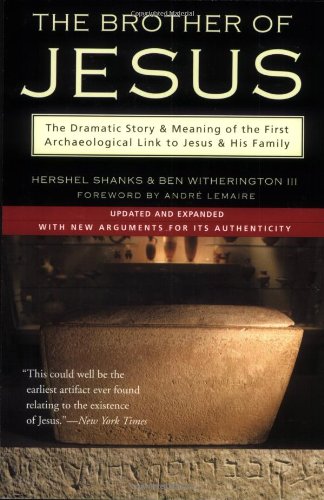by Hershel Shanks and Ben Witherington III
★★★★★
This is really two books in one, and both are excellent. Hershel Shanks (editor of my favorite mag, Biblical Archaeology Review) tells the story of the discovery of the James ossuary, and Ben Witherington describes the person both scholars believe this limestone burial box belonged to: James, the brother of Jesus. I’ve been following Shanks’ arguments in BAR over the years, so I already know he’s a proponent of the ossuary’s authenticity.
The box itself is inscribed “James, son of Joseph, brother of Jesus.” The Bible agrees: Jesus’ father was Joseph and one brother was James. The box was discovered in the collection of a private collector, who had no recollection of its origin … and no idea of its potentially incredible value. It’s dated pretty accurately to the first century, so while we cannot say with any certainty that it’s authentic to THE Jesus, both authors are convinced it’s an authentic first-century bone box.
This practice of removing the bones from the tomb and burying them again in a small box was practiced only for a short time, from about 20 BC to 70 AD. This, too, points to the period of Jesus. But what are the odds that this box once held the bones of the brother of Jesus? All three of these names—Jesus (Yeshua), James (Ya’akov), and Joseph (Yosef)—were quite common back then, but it’s still possible to estimate the odds. One estimate is that about 20 such James’s (with the indicated brother and father) would have lived in that period; another estimate is between 2 and 4. But how many would have a brother so famous that his brother’s name would be indicated on his ossuary? That would be a rarity. If this is the brother of the “real” Jesus, then, as Shanks posits, this little box may be “the most astonishing find in the history of archaeology.”
Then Witherington takes over halfway through the book to tell us about James, the brother of Jesus. Who he was, what he taught, how he died. While Peter and Paul may have become the most famous apostles, James was in reality probably the most important after the death of Jesus. He was appointed as the head of the Jerusalem church, the mother church.
Among other things, Witherington goes head to head with the Catholic doctrine of Mary’s perpetual virginity. While the Bible lists several brothers of Jesus, Catholics maintain that Mary remained a virgin after Jesus was born, and many believe the listed “brothers” are really just cousins. This idea was promoted by St. Jerome. Witherington quotes John P. Meier, a leading Catholic New Testament scholar, as saying that if the James ossuary is authentic, it is probably the last nail in the coffin of Jerome’s view of the brothers of Jesus being cousins.
I’ve always enjoyed the writings of both these authors, and this book doesn’t disappoint.

